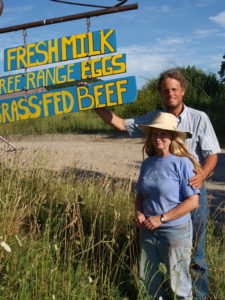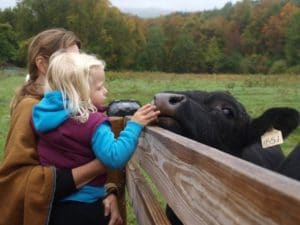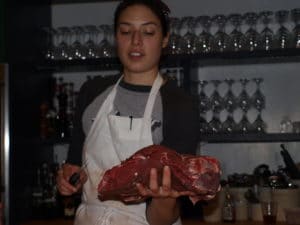Beef Cooperative Makes Dollars and Sense
By pooling product, the 25 farmer members of Adirondack Grazers have more than doubled their return on grass-fed beef.
New York State loses a farm every three days. For many of these farmers, the economics just didn’t work out: they were spending too much time and money producing, marketing and distributing their products to justify the return. The Adirondack Grazers is a grass-fed beef cooperative that is trying—and succeeding—in solving this problem. I talked to cooperative founder Sarah Teale to find out just how the 30 member cooperative managed to decrease the farmers’ workload while increasing their profits.
Sarah Teale is not only the beef cooperative founder, but is also a filmmaker— an Emmy-nominated filmmaker at that, who lives in Manhattan and produces groundbreaking documentaries for HBO. So first I had to ask: how did she end up running a grass fed beef cooperative in upstate New York?
“My husband had a farm up in Washington County for 30 years,” she explains. “A local farmer used to work the property for us and he had a dairy herd.” But like so many farms in the area, the farmer ended up selling the herd, and the fields became brushy once no one was actively cultivating them. One day, the farmer suggested to Sarah that she and her husband Gordon start a grass fed beef operation. The problem was, Sarah and Gordon actually couldn’t produce grass fed beef—not by themselves, and not in a way that was financially sustainable. Sarah recognized this after meeting with Cooperative Extension agent Sandy Buxton and subtracting the costs from the potential earnings to find out how much the farm could actually make with a beef herd. According to Sarah, “It turned out that we couldn’t make anything, and in fact we’d be losing money!”
Sharing the Dream
Sarah wanted to share the Adirondack Grazers’ success with other farmers, and even serve as a model for other groups looking to form cooperatives of their own. How convenient, then, that she is an Emmy-nominated filmmaker!
Sarah teamed up with Lisa Jackson (another Emmy-nominated filmmaker) to create a documentary on the Adirondack Grazers and its member farmers. The feature-length film is nearly finished and in fall of 2014 will be released to not only the cooperative members but also to farmers across the country. It could even end up on TV.
“I will be showing it to HBO, but I have no idea how interested people will be in a film about beef farmers,” Sarah laughs.
The Adirondack Grazers also intend to write a how-to pamphlet on the ins and outs of forming a cooperative.
“Maybe we can put the film inside the how-to pamphlets and get it out to everybody,” considers Sarah. “Maybe I’ll go write a grant for that too!”
Until the documentary and pamphlet are finished, the cooperative is using their website and Facebook page to provide outreach to farmers looking to start a cooperative or join the Adirondack Grazers who, it turns out, are currently looking for new members.
So Sarah came up with the idea of putting a cooperative together, as a way of collaborating with other beef producers to increase the amount of money the farmers could get for each pound of their beef. She set up a meeting in November of 2011 to gage interest and a surprising total of 40 farmers filled the room that day.
With the initial meeting and plenty of help from Cornell Cooperative Extension, Sarah had little difficulty finding farmers from upstate New York and Vermont who were willing to become members. but the next hurdle was finding a way to fund the project.
Sarah applied for and received a SARE grant after the November meeting and that money ended up being crucial to getting the project off the ground, paying for both the insurance and for a lawyer to incorporate the cooperative in June 2012. Later, it even funded farmer profiles which were posted on the Adirondack Grazers website to increase transparency to the customers.
Making Decisions Cooperatively
Once the Adirondack Grazers officially formed, they needed to devise a marketing plan targeting how and where to sell their beef: wholesale or direct, fresh or frozen, and the big question of pricing, were just some of the issues that the Grazers struggled with.
So the group set up a board made up of farmers who are members of the cooperative, plus Sarah, who “doesn’t quite count as a farmer.” The board started with 5 members who met weekly to discuss these questions and vote on a decision. The full membership meets every few months to vote on large decisions such as pricing. Sometimes, an early decision had to be changed down the line because things didn’t work out as well as expected: for example the attempt to sell frozen beef rather than fresh. It didn’t help that the Grazers’ freezer spontaneously broke down over the winter, but the real problem was with the demand.
“Down here in New York City the chefs don’t want frozen and the retail customers don’t want frozen either. Everybody wants fresh meat. Which is silly actually, but they don’t know that,” laughs Sarah.
On the other hand, the decision to sell wholesale instead of direct marketing was one that worked out quite well.
“We found that our sweet spot is wholesale,” Sarah says. “We tried to sell retail and direct. You can’t do it fresh because it’s too scary; you have to get rid of every piece.
And we found you can’t do it frozen either on the volume because you get rid of some hamburger and the steaks but then you’re left with a lot of the other things. You’re left with the eye rounds and the shanks and bits that people don’t know what to do with.”
So instead of wrestling with farmers markets, Sarah sells the beef to stores like Honest Weight in Albany and Healthy Living in Saratoga, to online markets like Fresh Direct, and to a number of butchers, distributors, and the odd restaurant that knows what to do with a whole cow.
Another decision which worked out surprisingly well was setting the price very high compared to commercial beef prices. In the beginning, the marketers (Sarah herself and Lisa Randles of White Clover Farm) had trouble selling the expensive meat, even in New York City where they focused most of their marketing. But commercial beef prices fluctuate up and down and are currently leaning heavily towards the “up” end of the spectrum, so the Adirondack Grazers’ beef, which is kept at a steady rate of $3.50 a pound, has become much easier to sell.
In general, the cooperative has worked out a good system for marketing and distributing their beef. The farmers drop their animals off at Eagle Bridge slaughterhouse. From there, the beef is transported to various restaurants and retail stores, and to New York City butchers and restaurants via food transporter “Fresh Connections.” (These connections were virtually all made by Sarah during a summer whirlwind spent running around New York with meat samples.) The cooperative then takes 15% to pay for the marketing and distribution, and the rest goes in a check straight back to the farmer.
The Bottom Line
Cooperative members are now taking in more than twice the money for their steers than they received before joining Adirondack Grazers. How does the cooperative model increase profits so much?
There are a few different ways, according to Sarah: first, the members work together to affect the markets. If one farmer contacts a butcher or distributor and says “I’ll sell you my beef for $3.50 a pound,” they are much less likely to get a sale from that than if all 25 farmers in the area demanded that same price.
The cooperative also takes care of marketing and distribution, so that each farmer doesn’t need to spend time and money driving four hours down to New York City in order to get a good price for their product. And finally, cooperatives open up markets such as restaurants that require a steady supply of beef every week, an idea which a small farm by itself just doesn’t have the volume to entertain.
All in all the cooperative members get a steady $2.98 per pound paid directly to them, regardless of the price of feed or commercial beef or fuel. This high price combined with the farmers’ increased herd sizes (a 55% increase since the cooperative was formed) has put the Adirondack Grazers on track to return a whopping $1 million to farmers this year.
Environmentally Friendly Beef
Though economics are the main driver for many farmers who choose to join a cooperative, the benefits aren’t only financial. The cooperative model is also environmentally friendly—at least where beef is concerned.

Adirondack Grazers Richard and Cynthia Larson operate a grass-fed beef operation located in Wells, Vermont.
“What we’ve shown to everybody is that there’s a huge market for 100% grass fed beef,” explains Sarah.
And the co-op members are taking notice. A few of the Adirondack Grazers farms still finish their animals on grain, but more and more are switching over to 100% grass fed because there is such a big market for it. That switch brings down costs from fuel, equipment, and grain, which again increases profit for the farmer but also makes the farm a lot more sustainable: every decrease in fuel, and especially every eliminated manure lagoon, decreases greenhouse gas emissions from the farm.
Even more than the per-farm emissions, cooperatives have the potential to increase the viability of the local foods movement itself. As Sarah puts it, “People like to think that local is happening and sustainable is happening, but it’s not happening on a scale yet that is sustainable. It’s being built on the backs of people driving four hours to a farmers market.”
So perhaps the solution to creating a food system that is truly locally and regionally based, which can sustain itself both environmentally and economically, is for farmers to cooperate— to create the economies of scale needed to be financially viable without sacrificing that small farm dream.
It’s certainly working for the Adirondack Grazers.
Anyone interested in joining the Adirondack Grazers’ Cooperative should call their office at 518-409-5599 or contact Sarah Teale at 917-941-0481. Learn more about SARE project number FNE12-738.





We are interested in starting a grass fed longhorn coop in north texas. Any information or guidance would be appreciated.